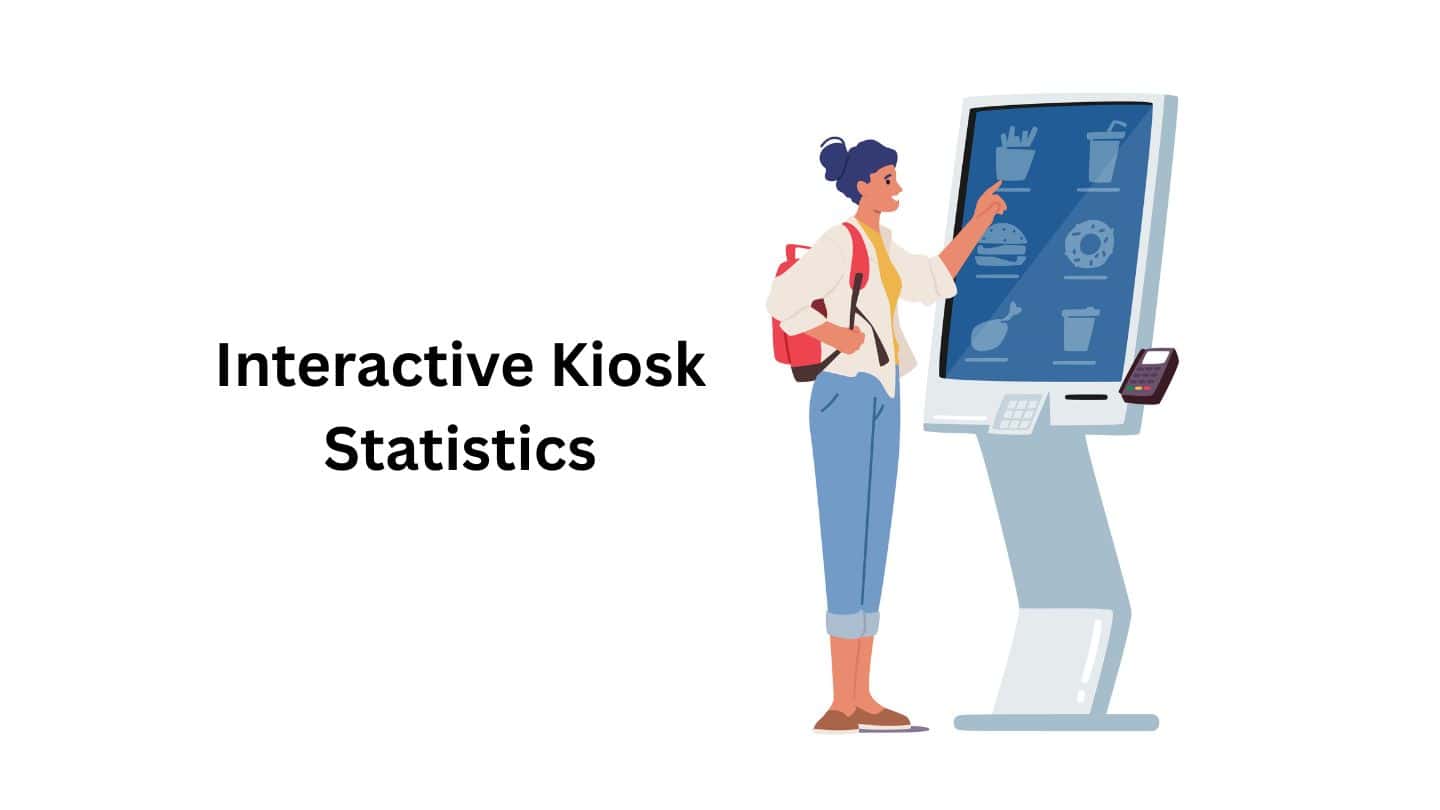Robots Statistics By Revenue, Usage and Companies

Updated · Mar 04, 2025


TABLE OF CONTENTS
- Introduction
- Editor’s Choice
- Facts About Robots
- Types of Robots
- General Robots Statistics
- Robots Industry Statistics by Market Share
- Industrial Robotics Market Volume Statistics
- Global Robots Revenue Statistics
- Annual Installation of Robots(Reference: ifr.org)
- Installed Robot Statistics by Country
- Robots Investment Statistics
- Robotics Statistics by Companies
- Robotics Statistics by Trending Industries
- Robot Statistics by Usage
- Robot Automation Workers’ Statistics
- Advantages and Disadvantages of Robotics
- Future Statistics of Robot Industries
- Conclusion
Introduction
Robots Statistics: Robots are becoming more common in different industries and everyday life. They help in factories, hospitals, homes, and even space exploration. As technology improves, robots are getting smarter and more efficient. Many businesses use robots to increase productivity, reduce costs, and complete tasks that are too dangerous for humans.
This article explores key statistics about robots, including the number being used, which industries rely on them the most, and how they impact jobs and the economy. It also examines trends in robotics and how they are shaping the future. Understanding these statistics helps us see how robots are changing the world and making life easier for people in many ways.
Editor’s Choice
- The global robots market is expected to reach USD 38.24 billion by 2024 and increase to USD 43.32 billion by 2027.
- Currently, there are over 3.4 million industrial robots in use worldwide.
- In manufacturing industries around the world, there is 1 robot for every 71 humans.
- Industrial companies are planning to spend about 25% of their capital on robots over the next five years.
- Robots have replaced 14% of jobs globally.
- In 2023, Asia had the highest number of robots, with 263.4 thousand units.
- The market for AI-powered robots is expected to grow to USD 184.75 billion by 2030.
- 83% of manufacturing industries use robots for tasks like palletizing and packaging.
- The main advantages of using robots include a 95% increase in production speed and a 92% increase in production capacity.
- By 2030, around 90% of businesses plan to use robotics.
You May Also Like To Read
- Augmented Reality Statistics
- Metaverse Statistics
- Virtual Reality Statistics
- Quantum Computing Statistics
- Biometrics Statistics
- Ransomware Statistics
- Robocalls Statistics
- Data Breach Statistics
- Laptop Statistics
- Desktops Statistics
- Smartphone Statistics
- VoIP Statistics
Facts About Robots
- As of 2024, over four million robots in factories worldwide, reflecting a 10% increase by 2024 and the previous year.
- Amazon invested significantly in robotics and artificial intelligence to enhance efficiency in its retail operations.
- Tesla released a video in September 2023 demonstrating Optimus sorting colored blocks and maintaining balance, indicating progress toward more complex functionalities.
- Agility Robotics introduced Digit, a humanoid robot that performs tasks like moving bins in warehouses. Digit represents a bridge between specialised automated machines and versatile humanoid robots.
- Figure AI launched Figure 02, a next-generation humanoid robot with enhanced capabilities, including increased battery life and advanced AI integration, targeting industrial applications.
- AgiBot commenced mass production of humanoid robots, with plans to ship 200 bipedal and 100 wheeled robots by the end of 2024. The company aims to revolutionize household assistance and industrial tasks.
Types of Robots
- The most used robots in 202 and 2024 are industrial robots; they can do all the work as humans, from surgeries to building cars and manufacturing parts.
- Traditional industrial robots are being used by 87% of companies worldwide to date.
- 55% of companies use collaborative robots, which can efficiently work without any human contact.
- Other types of robot statistics by company share are followed by automated guided vehicles (74%) and a robotic system by robots and human controllers (63%).
General Robots Statistics
- As of 2024, the global shipments of industrial robots are expected to reach 518,000 units.
- The market valuation of military robotics is estimated to be worth USD 16.5 billion by 2025.
- Across the global robots sector, approximately 150,000 workers are employed in engineering and assembly.
- CurrentlyCurrently, 88% of organizations have implemented robotic automation into their infrastructure.
- By 2025, more than 50,000 warehouses will install over 4 million commercial warehouse robots.
- The market valuation of warehouse robots is expected to account for USD 10.86 billion by 2030, with a CAGR of 11.8%.
- According to Strategic Market Research analysis, 2.1 million robots will be shipped by 2025, and 860,000 units will be shipped alone in 2025.
- Each year, roughly 400,000 new robots are invented across the global market.
- There are approximately 132,500 robotics engineers in the United States, and this number is projected to grow by 6.4% from 2016 to 2026.
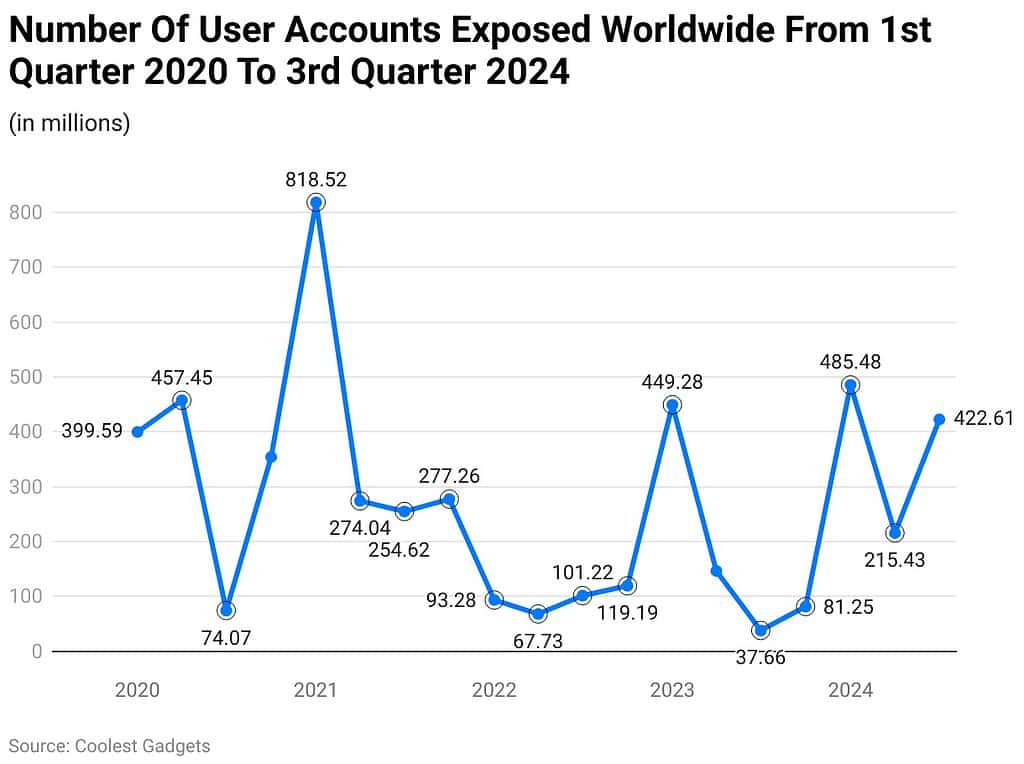
(Reference: zippia.com)
- According to the above line chart, the robot industry’s market size was USD 104.6 billion in 2023, and it is estimated to be USD 117.2 billion by 2024.
- Furthermore, the market size of the robot industry is going to reach higher such as 2025 (USD 129.1 billion), 2026 (USD 141.2 billion), 2027 (USD 153.4 billion), and 2028 (USD 165.3 billion).
- Revenue growth of the North American robotics industry will be 11.67% of CAGR by 2026.
You May Also Like To Read
- iPhone Vs. Android Statistics
- Google Pixel Smartphones Statistics
- iPhone vs Android Users Statistics
- Mesh Wi-Fi System Statistics
- Western Digital Statistics
- Cloud Gaming Service Statistics
- Virtual Reality Headset Statistics
- AI in Robotics Statistics
- 3D Printers Statistics
- Smart City Statistics
- 3D Printing Statistics
Industrial Robotics Market Volume Statistics
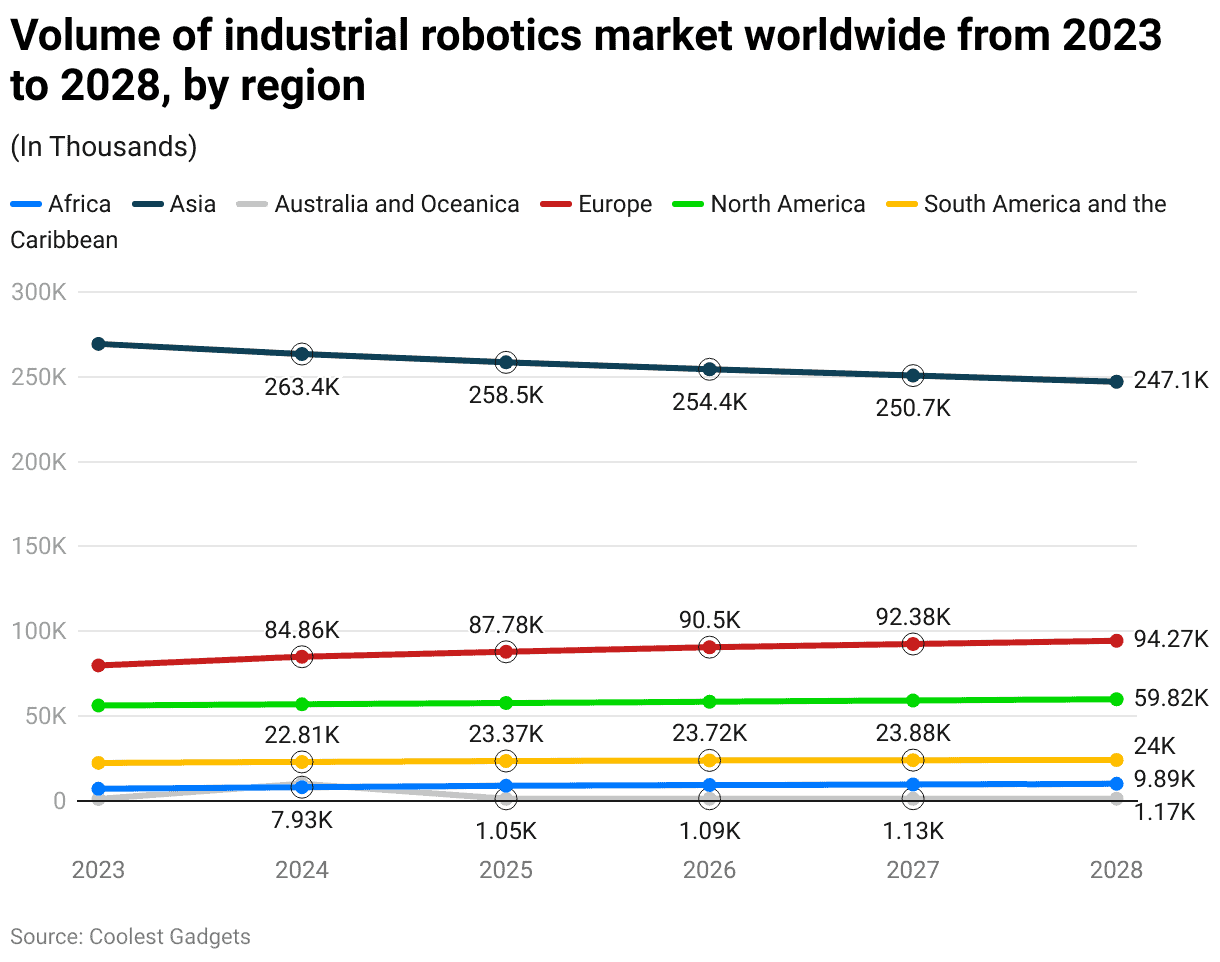
(Reference: statista.com)
- In 2023, Asia had the highest number of industrial robots, reaching 269.4K units.
- Other regions followed, with Europe at 79.75K, North America at 56.05K, South America and the Caribbean at 22.24K, Africa at 6.94K, and Australia and Oceania at 0.96K.
- By 2024, the global industrial robot market had changed. Asia’s volume dropped slightly to 263.4K.
- In comparison, Europe’s population increased to 84.86 K, North America’s population rose to 56.79K, South America and the Caribbean reached 22.81K, Africa climbed to 7.93K, and Australia and Oceania recorded 1 K.
- Projections for 2025 to 2028 suggest that Asia’s market will gradually decline from 258.5K to 247.1K.
- Meanwhile, Europe (87.78K to 94.27K) and North America (57.6K to 59.82K) are expected to grow.
- Other regions, including South America, Africa, Australia, and Oceania, will see steady increases over the coming years.
Global Robots Revenue Statistics
- Worldwide revenue earned by the robotic market was almost USD 37.37 billion in 2023.
- Whereas, in 2024, the robotic service revenue will account for the majority share of industrial revenue, resulting in USD 38.24 billion
- Meanwhile, the global robotics market is expected to grow gradually over the next few years, according to Statista reports. 2025 (USD 40.04 billion), 2026 (USD 41.78 billion), 2027 (USD 43.32 billion), and 2028 (USD 45.1 billion) will follow.
Annual Installation of Robots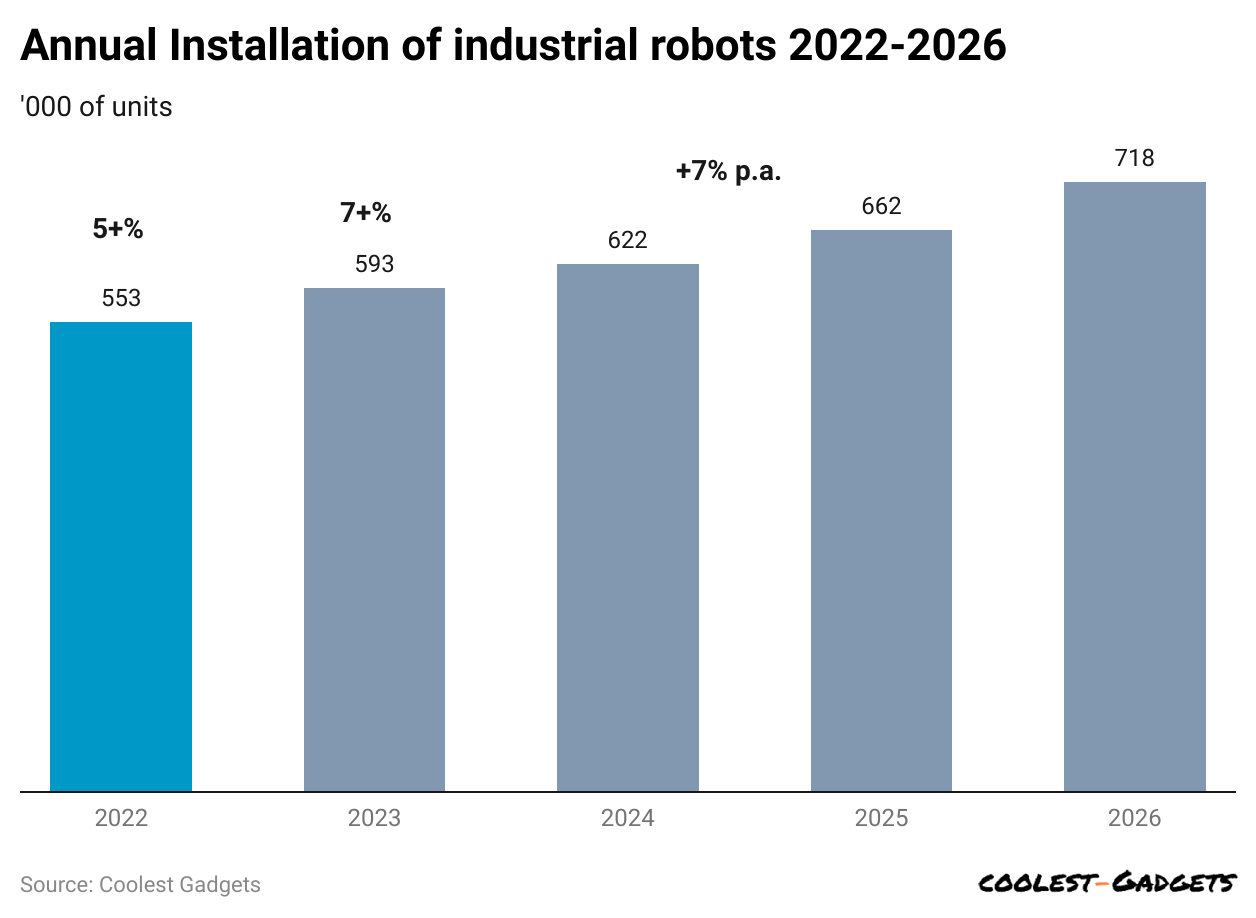 (Reference: ifr.org)
(Reference: ifr.org)
- According to the International Federation of Robotics, industrial robot installation in global industries and factories in 2023 resulted in 553K, along with a growth rate of 7%.
- Furthermore, it is expected that in coming years, the installation rates of industrial robots are going to increase, followed by 2024 (622K), 2025(662K) with a 7% growth rate, and 2026 (718K).
- By the end of 2023, around 73% of deployed robots in Asia were installed in Europe (10%) and the United States (10%).
Installed Robot Statistics by Country
- As of 2023, global robot installations are expected to grow 7% from last year, above 590,000 units, 600,000 units by 2024, and 700,000 units by 2026.
- The top 5 countries, the United States, China, the Republic of Korea, Japan, and Germany, have installed around 79% of robots in 2023.
- The United States of America is supposed to generate the highest market revenue, USD 7.85 billion, in 2024.
- In China, the market size is expected to reach USD6.28 billion by 2024 and USD11.8 billion by 2032, with a CAGR of 7.5% from 2023 to 2032.
- Expected robotics revenue earned by other countries in 2024 is followed by the Republic of Korea (USD1.64 billion), Japan (USD2.53 billion), and Germany (USD3.12 billion).
Robots Investment Statistics
- By the coming five years, industrial companies will likely invest around 25% of their capital in robots.
- Approximately 23% of retail manufacturing industries plan to invest more than USD500 million in robots and automation.
- On the other hand, 15% of food and beverage manufacturers have also planned to invest at least USD500 million in upgrading robotics systems.
Robotics Statistics by Companies
- According to a report by Zippia, the five biggest robotics companies worldwide are Honda Motor, Siemens AG, Sony, Denso Corporation, and Midea Group.
- As of 2023, Honda Motor had the highest revenue and market capitalization in the robots industry, with USD142 billion and USD42 billion, respectively.
- Other top 4 companies earned revenue and market cap are followed by Siemens (USD97 billion and USD75 billion), Sony (USD79 billion and USD78 billion), Denso Corp. (USD47 billion and USD227 billion), and Midea Group (USD39 billion and USD52 billion).
- Based on industry type, the total number of robot installations statistics are followed by electronics (137,000), automotive (119,000), metal and machinery (64,000), plastic and chemicals (24,000), and food (15,000).
Robotics Statistics by Trending Industries
- As of March 2023, the automotive industry’s operational robot stock accounted for around 1 million units, and investments are primarily observed in the top car-producing industries.
- China is the largest car producer in the world, but it has a low robot density of 772 units.
- The Republic of Korea (2,867 units), Germany (1500 units), the United States of America (1457 units), and Japan (1422 units) are the other countries with the highest industrial robot density in the automotive industry.
- By the end of 2023, the automotive industry has grown by 3.5% after implementing robots.
- Meanwhile, the robotics market size in the pharmaceutical industry is expected to reach USD357.9 million by 2030.
- As of 2023, the medical robot market has reached above USD 10 billion, and the agricultural robot market is predicted to reach USD 81 billion by 2028.
- Lastly, the market growth of military robotics is supposed to be across 7% of CAGR from 2021 to 2027.
Robot Statistics by Usage
- As of 2024, robots are primarily used in 83% of manufacturing industries for palletization and packaging.
- 82% of robotic automation is used for ground movements and material handling.
- Other usage shares of robots are followed by goods receiving and storage (80%), material handling and forklifts (77%), and sorting (75%).
- As of 2025, robots will be implemented to manufacture 75% of global vehicles.
- In the 1st quarter of 2023, an order of 9,169 unit robots was placed by United States businesses, resulting in USD 598 billion.
- Almost 67 countries have implemented more than 7.2 million robotic surgeries in the last ten years in the previous ten years.
Robot Automation Workers’ Statistics
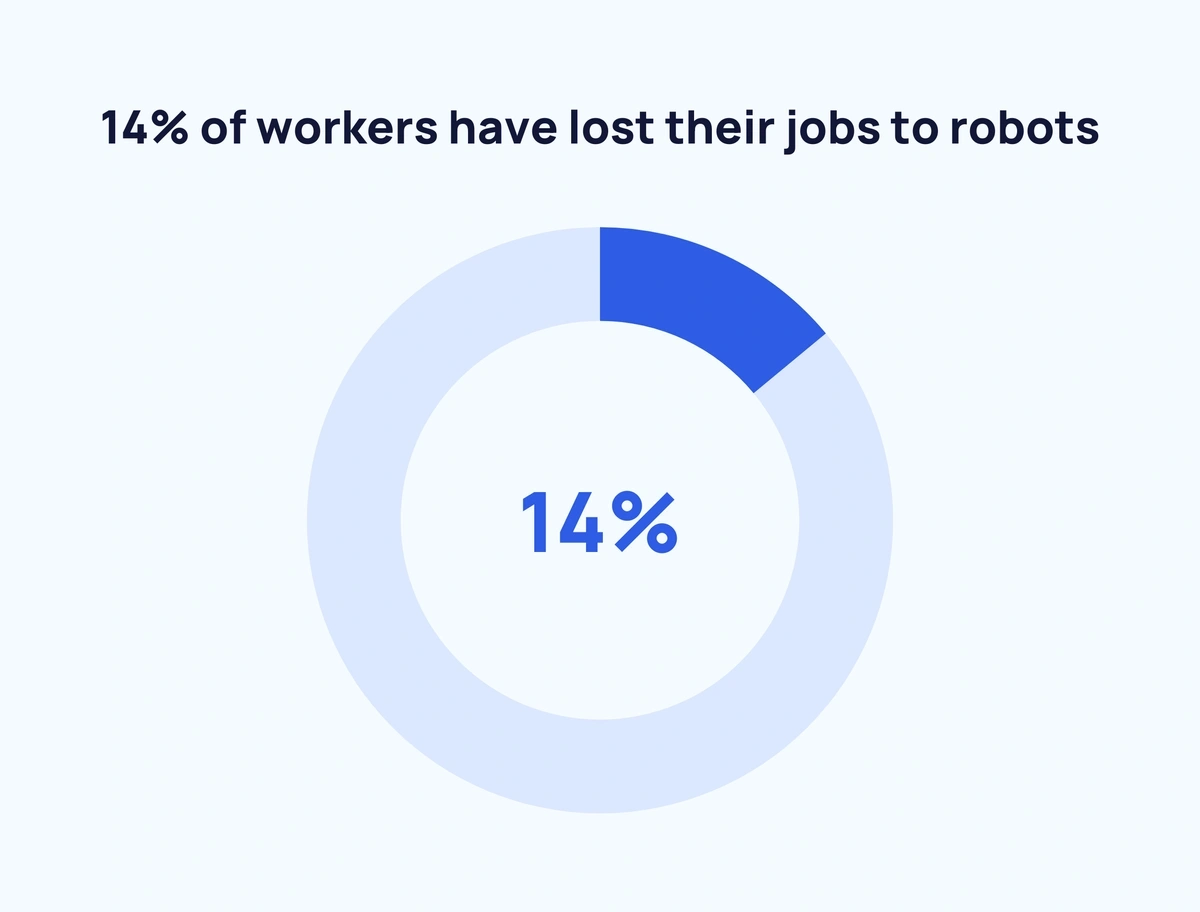
(Source: buttercms.com)
- To date, almost 14% of global workers have lost their jobs after robots were installed in different industries.
- As of 2023, almost 47% of individual jobs have been replaced by automation.
- Meanwhile29% of workers have secured positions in global industries as of now.
- According to a report published by Exploding Topics, 65% of robotics engineers have a four-year bachelor’s degree.
- Other degrees of robotic engineers are associate’s degree (15%) and high school diploma (3%).
- The average annual salary earned by robotic engineers is followed by a bachelor’s degree (USD 99,309), a master’s degree (USD 112,368), and a doctorate (USD 124,995).
- Based on working statistics, 28% of robotic engineers worked in companies with employees between 100 and 500; others are private companies (66%) and public companies (25%).
Advantages and Disadvantages of Robotics
- Companies that have already implemented robots allowed them to save costs up to 20% in 2023 and are expected to hit 22% by the end of 2025.
- By 2025, industrial robots are supposed to displace 85 million human jobs.
- The cost of robots is higher; thus, as 16% of survey respondents in 2024 stated, this is the top challenge many companies cannot implement to date.
Future Statistics of Robot Industries
- The leading robotic user is the automotive sector and is predicted to reach USD 447.8 million by 2027 with a CAGR of 12.3%.
- In the food industry, approximately 90,000 robots are currently used.
- The market valuation of the Food Robotics by 2027 is estimated to grow around USD 6.6 billion.
- The expected market worth of the healthcare robotics industry will be USD 3.29 billion by 2025, with a growth rate of 22.9% and USD 15.4 billion by 2030.
- Meanwhile, the robotic surgeries market is expected to be USD 20.98 billion by the end of 2030, with a CAGR of 15.77% from 2020 to 2030.
- The hospital robotics market is estimated to approach USD 20 billion by 2028 with a CAGR of 14%.
- The industry valuation of wearable exoskeleton robotics will reach USD 3.2 billion by 2027, with a CAGR of 22%.
- Meanwhile, the nursing robotics market is supposed to be valued at over USD 1.5 billion and grow at a CAGR of 20% by 2027.
- In the U.S., by 2032, the market size of electronic and industrial robots will reach USD 5,855.9 million, with a growth rate of 11.8%.
Conclusion
After completing the article on robot statistics, it can be stated that robots have become an integral part of worldwide industries as they can perform dangerous and complex work with more enhanced solutions. The robotic implementation also includes several advantages and disadvantages, but most sectors and companies focus on earning higher production rates and revenue shares.
This article has helped you understand different segmental analyses of the global robots market based on recent years and some future predictions.
Sources

Joseph D'Souza started Coolest Gadgets in 2005 to share his love for tech gadgets. It has since become a popular tech blog, famous for detailed gadget's reviews and companies statistics. Joseph is committed to providing clear, well-researched content, making tech easy to understand for everyone. Coolest Gadgets is a trusted source for tech news, loved by both tech fans and beginners.







